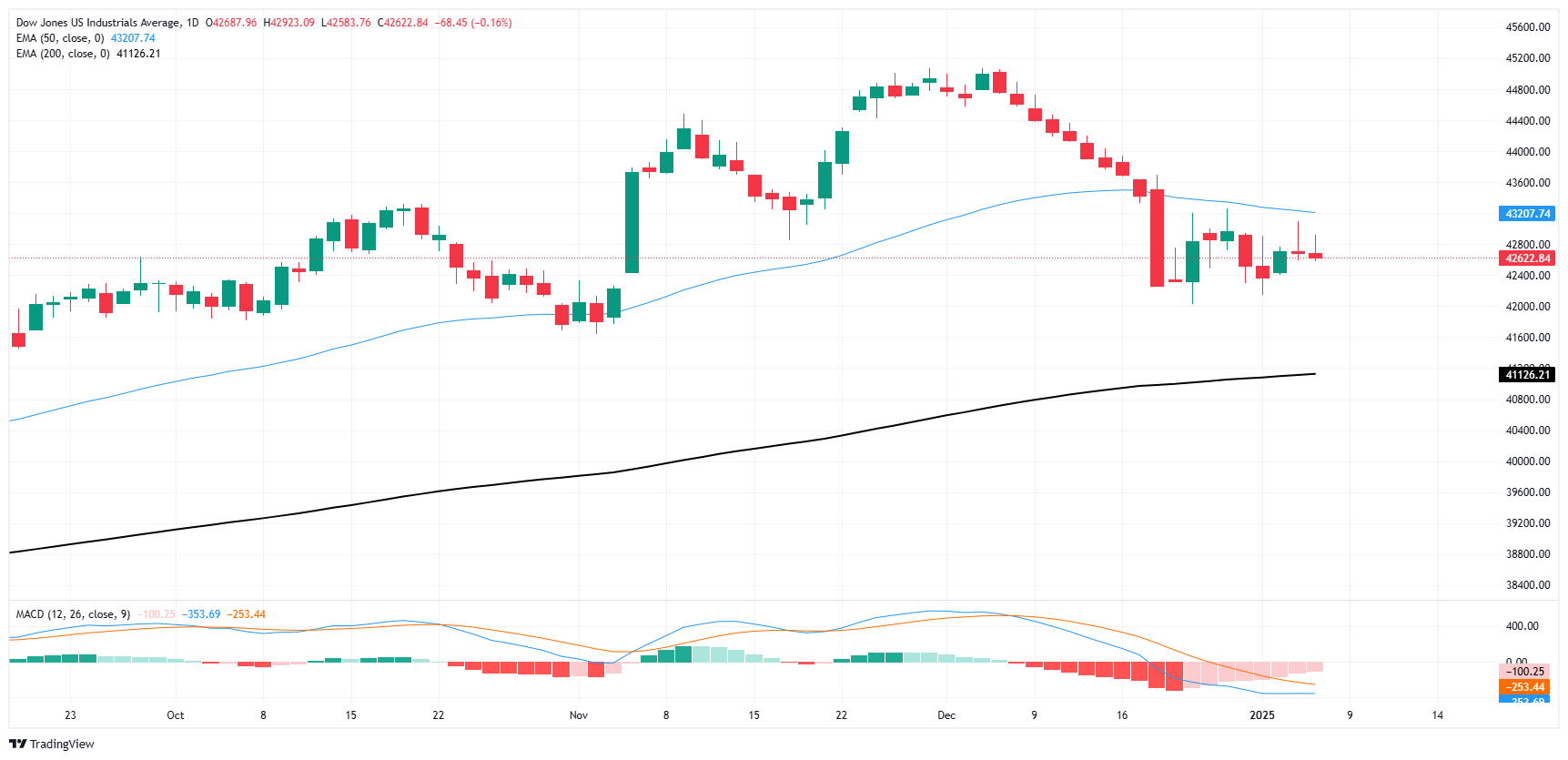Dow Jones Industrial Average freezes as investors balk at too much growth
- The Dow Jones was mired in congestion near 43,000 on Tuesday.
- US ISM PMI figures came in much hotter than expected in December.
- Above-forecast business survey results are reigniting fresh fears of fewer Fed cuts.
The Dow Jones Industrial Average (DJIA) churned on Tuesday as tech stocks pared back recent gains, with investors pushed further off their Goldilocks stance after a hotter-than-expected print in December’s ISM Purchasing Managers Index (PMI) crimped rate cut hopes heading into 2025.
Equity markets hoping to extend last year’s AI-fueled tech bull run into the new year ran into a hard wall on Tuesday, with key darlings of the tech space giving back recent gains. Profit-focused shareholders bluntly want their preferred silicon wafer-punching companies to lean further into demand from the AI tech space, even as the segment of that sector that deals with actually selling AI solutions to consumers and businesses struggle to develop stable methods of generating profit.
ISM’s Services PMI print for December came in well above median market forecasts, clocking in at 54.1 versus the expected 53.3 and rebounding firmly from the previous month’s 52.1. ISM Services Priced Paid survey results also accelerated to a 22-month high of 64.4 in December compared to November’s 58.2.
With business activity outlooks broadly rising faster than expected, as well as prices paid by those businesses appearing to be back on the rise, investors are balking at the prospect of inflation remaining stickier than previously expected. Firm business activity growth plus rising producer prices will make it more difficult for the Federal Reserve (Fed) to deliver as many rate cuts as traders were hoping.
According to the CME’s FedWatch Tool, rate traders now expect the Fed to hold off on any further rate cuts until June. The Fed is expected to stand pat on rates through most of the first half of 2025.
Dow Jones news
A little over half of the companies listed on the Dow Jones are testing into the green on Tuesday, keeping the headline index on balance despite heavier downside in key tech stocks. Nvidia (NVDA) tumbled over 5%, falling back below $142 per share as investor expectations for the chipmaker cool off. The company recently unveiled a new range of chipsets based on its now-familiar Blackwell architecture, but its decision to focus the latest release on a back-to-its-roots pivot to providing hardware for gaming rigs received a delayed tepid response from AI tech investors who initially bid the company up earlier in the week.
Dow Jones price forecast
A rough consolidation pattern is cooking into the Dow Jones chart, keeping the major equity index hobbled in a choppy range between 43,000 and 42,000. Short pressure remains unable to push price action firmly into a downside trajectory, and bids remain bolstered into a technical ceiling from the 50-day Exponential Moving Average (EMA) descending through 43,200.
Bulls tired of punching the buy button could run out of gas after keeping the Dow Jones pushed into a one-sided bullish trend. The DJIA has outpaced its own 200-day EMA for 14 straight months, and bidders could be tired of winning, which could see the index pare further gains and fall back to softer chart regions.
Dow Jones daily chart
Dow Jones FAQs
The Dow Jones Industrial Average, one of the oldest stock market indices in the world, is compiled of the 30 most traded stocks in the US. The index is price-weighted rather than weighted by capitalization. It is calculated by summing the prices of the constituent stocks and dividing them by a factor, currently 0.152. The index was founded by Charles Dow, who also founded the Wall Street Journal. In later years it has been criticized for not being broadly representative enough because it only tracks 30 conglomerates, unlike broader indices such as the S&P 500.
Many different factors drive the Dow Jones Industrial Average (DJIA). The aggregate performance of the component companies revealed in quarterly company earnings reports is the main one. US and global macroeconomic data also contributes as it impacts on investor sentiment. The level of interest rates, set by the Federal Reserve (Fed), also influences the DJIA as it affects the cost of credit, on which many corporations are heavily reliant. Therefore, inflation can be a major driver as well as other metrics which impact the Fed decisions.
Dow Theory is a method for identifying the primary trend of the stock market developed by Charles Dow. A key step is to compare the direction of the Dow Jones Industrial Average (DJIA) and the Dow Jones Transportation Average (DJTA) and only follow trends where both are moving in the same direction. Volume is a confirmatory criteria. The theory uses elements of peak and trough analysis. Dow’s theory posits three trend phases: accumulation, when smart money starts buying or selling; public participation, when the wider public joins in; and distribution, when the smart money exits.
There are a number of ways to trade the DJIA. One is to use ETFs which allow investors to trade the DJIA as a single security, rather than having to buy shares in all 30 constituent companies. A leading example is the SPDR Dow Jones Industrial Average ETF (DIA). DJIA futures contracts enable traders to speculate on the future value of the index and Options provide the right, but not the obligation, to buy or sell the index at a predetermined price in the future. Mutual funds enable investors to buy a share of a diversified portfolio of DJIA stocks thus providing exposure to the overall index.


